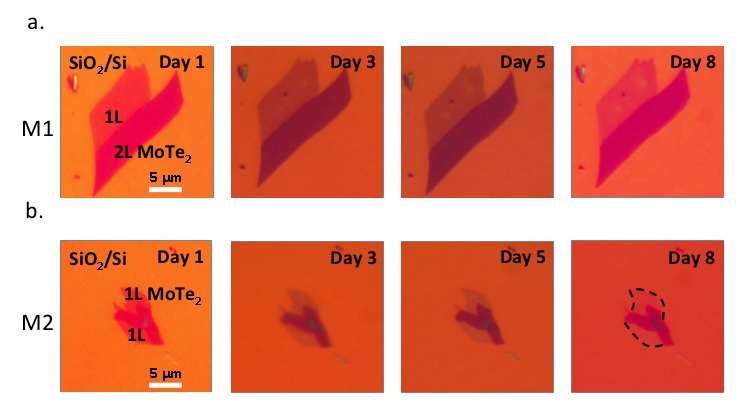May 5, 2015 report
Two-dimensional material seems to disappear, but doesn't

(Phys.org)—When exposed to air, a luminescent 2D material called molybdenum telluride (MoTe2) appears to decompose within a couple days, losing its optical contrast and becoming virtually transparent. But when scientists probed further, they found that the disappearance is an illusion: the material remains structurally stable, and only its material properties change. The results reveal insight into the environmental stability and unusual properties of a newer class of 2D materials called transition metal dichalcogenides (TMDs).
The researchers, led by Sefaattin Tongay, Assistant Professor at Arizona State University, have published a paper on the changing luminescence in a recent issue of ACS Nano.
"Currently, many researchers throughout the world are demonstrating very impressive and promising proof-of-concept applications using 2D material systems, but we still do not know their material stability over long periods of time," Tongay told Phys.org. "This research presents the unique case of MoTe2, the only infrared-range TMD, where monolayers visually disappear but are physically still there."
Like other TMDs, MoTe2 stands out for its interesting optical properties. In bulk form, TMDs are not luminescent, but when one-atom-layer-thick flakes are exfoliated from the bulk, the 2D flakes become semiconductors and emit light rather strongly. For this reason, 2D semiconducting TMDs could have applications in optoelectronics and solar energy conversion technologies. As the only TMD that has an infrared-range band gap, MoTe2 is particularly suitable for infrared detectors and tunnel field-effect transistors.
Because 2D materials have a large surface-to-volume ratio, their properties can be affected by interactions between their surface and the environment. Noting that tellurium compounds are particularly sensitive to oxygen, the researchers here wanted to investigate what happens when monolayer MoTe2 is exposed to oxygen for several days.
The researchers began by observing the material under an optical microscope with an infrared lens. They found that MoTe2 flakes that were highly luminescent to begin with maintained their brightness over the 8-day observation period. On the other hand, weakly luminescent flakes unexpectedly appeared to fade within 1-3 days, and parts of them disappeared altogether.
However, when viewing the "vanishing" flakes using an atomic force microscope (AFM), which scans samples mechanically rather than optically, the researchers saw the flakes "reappear." The flakes had never disappeared in the first place, but their optical properties had changed while their chemical structure was maintained.
The researchers propose that the reason why the weakly luminescent flakes seem to disappear is that they have a large number of defects, particularly vacancies due to missing atoms. These vacancies are why the flakes have a low starting luminescence, and also explain why they lose their luminescence when exposed to oxygen. Oxygen molecules (O2) from the air become embedded in these defects and bind to Mo and Te, forming "deep states" that basically trap electrons and holes, effectively prohibiting luminescence. On the other hand, flakes that are highly luminescent to begin with have a small number of defects, so they don't absorb nearly as many oxygen molecules, don't suffer loss of luminescence, and their optical properties remain close to their properties under vacuum conditions.
"This work shows that a slim amount of defects in MoTe2 can have a great impact on their material properties, such as optical, electrical, and vibrational, and these changes occur gradually over time similar to aging wine: depending on the defect concentration, MoTe2 monolayers can spoil over time (or might get better)," Tongay explained.
The results here show that the defects play a significant role in the optical properties and stability of MoTe2, and could also reveal insight into the environmental stability of other 2D materials, such as silicene (2D silicon), phosphorene (2D phosphorous), and other TMDs. It could also lead to ways to control these materials' properties.

"This is an important discovery in that it practically implies that we are able to tune the optical properties of 2D MoTe2 by manipulating the defect density in the material and preventing the material from losing its intrinsic attributes by improving the quality of crystal," said Bin Chen, PhD student at Arizona State University and lead author of the paper.
In the future, the researchers plan to explore and establish the stability of other 2D material systems, as well as boost their properties by molecular functionalization through existing or intentionally created defect points.
"Despite encouraging results and impressive applications, our results point toward environmental instability over a time period of a month," Chen said. "We hope to understand this and ideally overcome these challenges using our knowledge and expertise in materials science and engineering."
More information: Bin Chen, Hasan Sahin, et al. "Environmental Changes in MoTe2 Excitonic Dynamics by Defects-Activated Molecular Interaction." ACS Nano. DOI: 10.1021/acsnano.5b00985
Journal information: ACS Nano
© 2015 Phys.org





















